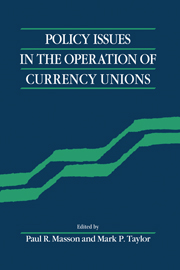Book contents
- Frontmatter
- Contents
- List of contributors
- Preface
- I Assessing the literature
- II Existing currency unions
- III Is Europe an optimum currency area?
- 5 Is Europe an optimum currency area?: evidence from regional data
- 6 Labor markets and European monetary unification
- 7 European excess stock returns and capital market integration: an empirical perspective
- IV EMU: The road from Maastricht
- Index
5 - Is Europe an optimum currency area?: evidence from regional data
from III - Is Europe an optimum currency area?
Published online by Cambridge University Press: 04 August 2010
- Frontmatter
- Contents
- List of contributors
- Preface
- I Assessing the literature
- II Existing currency unions
- III Is Europe an optimum currency area?
- 5 Is Europe an optimum currency area?: evidence from regional data
- 6 Labor markets and European monetary unification
- 7 European excess stock returns and capital market integration: an empirical perspective
- IV EMU: The road from Maastricht
- Index
Summary
Introduction
The traditional theory of optimum currency areas, as developed by Mundell (1961), has identified the conditions under which a monetary union between regions or countries will work smoothly. In a nutshell this theory says that when regions or countries are subjected to different disturbances (asymmetric shocks) the adjustment process will require either real exchange rates to adjust, or factors of production to move, or a combination of these two. In the absence of real exchange-rate flexibility and factor mobility, regional or national concentrations of unemployment will be inevitable.
The theory of optimum currency areas has also established a presumption that in a monetary union the adjustment mechanism will rely more on factor mobility than on real exchange-rate flexibility. Of course, in a monetary union the real exchange rates of regions can change, because of divergent regional movements of prices. However, it is likely that the regional adjustment process following asymmetric shocks will rely less on these relative price changes than on mobility of labor. Exactly the opposite holds for countries with separate currencies. The presumption here is that more of the adjustment to asymmetric shocks will take the form of real exchange-rate changes than of labor mobility. The reason is that countries can change their nominal exchange rates. (For a fundamental contribution see Vaubel, 1976. See also Meltzer, 1986.)
The purpose of this chapter is twofold. First it aims at contrasting the nature of the adjustment mechanism between regions of the same country, and between countries in Europe.
- Type
- Chapter
- Information
- Policy Issues in the Operation of Currency Unions , pp. 111 - 129Publisher: Cambridge University PressPrint publication year: 1993
- 48
- Cited by



